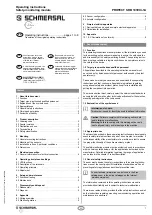
5
PROTECT SRB 101EXi-1A
Operating instructions
Safety-monitoring module
EN
Only touch the components after electrical discharge!
U
EXi
U
B
U
i
K1
K2
SRB
101EXi
-1A
0V X1 X3
S11 S12 S21 S22
13 14 21 22
PA PA A1 A2
U
EXi
U
B
U
i
K1
K2
SRB
101EXi
-1A
0V X1 X3
S11 S12 S21 S22
13 14 21 22
PA PA A1 A2
S11 S12 S21 S22
PA PA A1 A2
nQS
QS
Fig. 3
Fig. 4
Fig. 5
6 Set-up and maintenance
6.1 Functional testing
The safety function of the safety-monitoring module must be tested.
The following conditions must be previously checked and met:
1. Correct fixing
2. Check the integrity of the cable entry and connections
3. Check the safety-monitoring module’s enclosure for damage.
4. Check the electrical function of the connected sensors and their
influence on the safety-monitoring module and the downstream
actuators
6.2 Maintenance
A regular visual inspection and functional test, including the following
steps, is recommended:
1. Check the correct fixing of the safety-monitoring module
2. Check the cable for damages
3. Check electrical function
The device has to be integrated into the periodic check-ups
according to the Ordinance on Industrial Safety and Health/the
ATEX Directive (99/92/CE), however at least 1x/year.
Troubleshooting
No changes are allowed to devices, which are used in conjunction
with explosion-endangered areas.
Repairs to the devices are not authorised either.
Damaged or defective components must be replaced.
7 Disassembly and disposal
7.1 Disassembly
The safety-monitoring module must be disassembled in a de-energised
condition only.
7.2 Disposal
The safety-monitoring module must be disposed of in an appropriate
manner in accordance with the national prescriptions and legislations.
8 Appendix
8.1 Wiring examples
Dual-channel control, shown for a guard door monitor with two
position switches where one has a positive break contact; with
external reset button
J
(Fig. 6)
• Relay outputs: Suitable for 2-channel control, for increase in capacity
or number of contacts by means of contactors or relays with positive-
guided contacts.
• The control system recognises wire-breakage, earth faults and cross-
wire shorts in the monitoring circuit.
•
S
= Feedback circuit
0V S12
J
S11 S21 S22
K
B
K
A
K
A
K
B
K
A
K
B
K2
K1
A2
PA PA
N
14
22
d)
S
c)
b)
a)
K1
K2
U
i
U
EXi
F1
F2
U
B
13
L1
+24 VDC
21
A1
X1 X3
nQS
QS
Fig. 6
a) Installation in zone 1/21
b) Installation in zone 2
c) Logic
d) Control
8.2 Start configuration
External reset button (without edge detection) (see Fig. 7)
• The reset button is integrated in the feedback circuit in series
as shown.
• The safety-monitoring module is activated upon actuation of
the reset button.
• The reset button is controlled through an individual
intrinsically safe current circuit.
• To start the safety-monitoring module, the reset button
may be designed as “simple electrical apparatus”.
• Examples see chapter 9 Simple “electrical apparatus – intrinsic safety”
Automatic start (see Fig. 8)
• The automatic start is programmed by connecting the feedback
circuit to the terminals. If the feedback circuit is not required,
establish a bridge.
• The feedback circuit is controlled through an individual intrinsically
safe current circuit.
• Caution:
Not admitted without additional measure due to the risk
of gaining access by stepping behind!
• within the meaning of EN 60204-1:2006 paragraph 9.2.5.4.2 and
10.8.3, the operating mode “automatic start” is only restrictedly
admissible. In particular, any inadvertent restart of the machine
must be prevented by other suitable measures.








